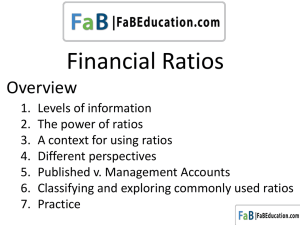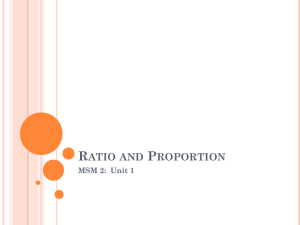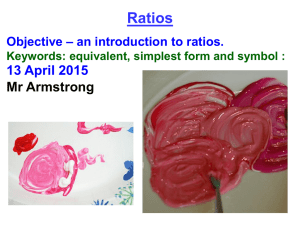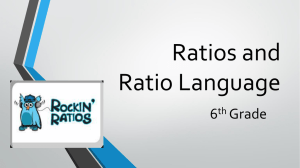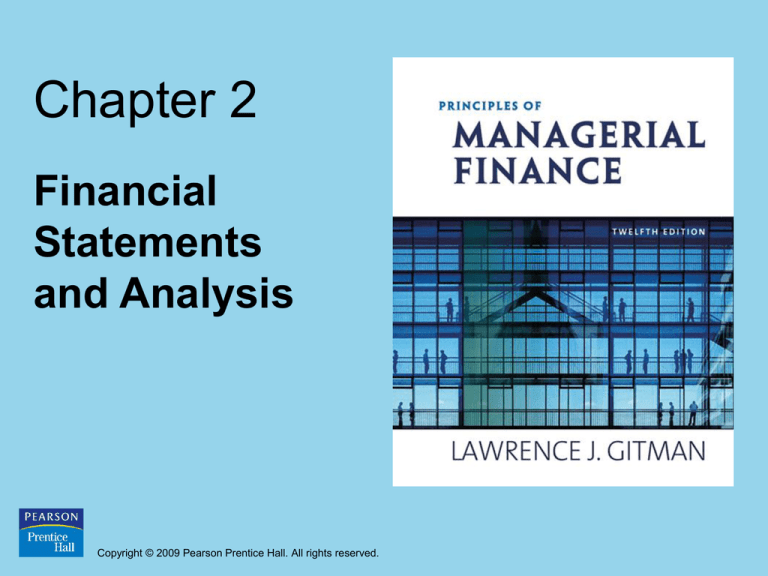
Chapter 2
Financial
Statements
and Analysis
Copyright © 2009 Pearson Prentice Hall. All rights reserved.
Learning Goals
1. Review the contents of the stockholders’ report and
the procedures for consolidating international
financial statements.
2. Understand who uses financial ratios, and how.
3. Use ratios to analyze a firm’s liquidity and activity.
4. Discuss the relationship between debt and financial
leverage and the ratios used to analyze a firm’s debt.
Copyright © 2009 Pearson Prentice Hall. All rights reserved.
2-2
Learning Goals (cont.)
5. Use ratios to analyze a firm’s profitability and
market value.
6. Use a summary of financial ratios and the
DuPont system of analysis to perform a
complete ratio analysis.
Copyright © 2009 Pearson Prentice Hall. All rights reserved.
2-3
The Four Key Financial Statements:
The Income Statement
• The income statement provides a financial
summary of a company’s operating results
during a specified period.
• Although they are prepared annually for
reporting purposes, they are generally computed
monthly by management and quarterly for tax
purposes.
Copyright © 2009 Pearson Prentice Hall. All rights reserved.
2-4
The Four Key Financial Statements
Table 2.1 Bartlett
Company Income
Statements ($000)
Copyright © 2009 Pearson Prentice Hall. All rights reserved.
2-5
The Four Key Financial Statements:
The Balance Sheet
• The balance sheet presents a summary of a
firm’s financial position at a given point in time.
• Assets indicate what the firm owns, equity
represents the owners’ investment, and liabilities
indicate what the firm has borrowed.
Copyright © 2009 Pearson Prentice Hall. All rights reserved.
2-6
The Four Key Financial Statements
Table 2.2a Bartlett
Company Balance
Sheets ($000)
Copyright © 2009 Pearson Prentice Hall. All rights reserved.
2-7
The Four Key
Financial Statements (cont.)
Table 2.2b Bartlett
Company Balance
Sheets ($000)
Copyright © 2009 Pearson Prentice Hall. All rights reserved.
2-8
The Four Key Financial Statements:
Statement of Retained Earnings
• The statement of retained earnings reconciles the
net income earned and dividends paid during the
year, with the change in retained earnings.
Copyright © 2009 Pearson Prentice Hall. All rights reserved.
2-9
The Four Key Financial Statements
Table 2.3 Bartlett Company Statement of Retained Earnings
($000) for the Year Ended December 31, 2009
Copyright © 2009 Pearson Prentice Hall. All rights reserved.
2-10
The Four Key Financial Statements:
Statement of Cash Flows
• The statement of cash flows provides a
summary of the cash flows over the period of
concern, typically the year just ended.
• This statement not only provides insight into a
company’s investment, financing and operating
activities, but also ties together the income
statement and previous and current balance
sheets.
Copyright © 2009 Pearson Prentice Hall. All rights reserved.
2-11
The Four Key Financial Statements
Table 2.4 Bartlett
Company Statement of
Cash Flows ($000) for
the Year Ended
December 31, 2009
Copyright © 2009 Pearson Prentice Hall. All rights reserved.
2-12
Using Financial Ratios:
Interested Parties
• Ratio analysis involves methods of calculating
and interpreting financial ratios to assess a
firm’s financial condition and performance.
• It is of interest to shareholders, creditors, and the
firm’s own management.
Copyright © 2009 Pearson Prentice Hall. All rights reserved.
2-13
Using Financial Ratios:
Types of Ratio Comparisons
• Trend or time-series analysis
• Cross-sectional analysis
* Industry comparative analysis
* Benchmarking
* Combined
Copyright © 2009 Pearson Prentice Hall. All rights reserved.
2-14
Using Financial Ratios:
Types of Ratio Comparisons (cont.)
Table 2.5 Industry Average Ratios for Selected Lines of
Businessa
Copyright © 2009 Pearson Prentice Hall. All rights reserved.
2-15
Using Financial Ratios:
Types of Ratio Comparisons (cont.)
Figure 2.1 Combined Analysis
Copyright © 2009 Pearson Prentice Hall. All rights reserved.
2-16
Using Financial Ratios:
Cautions for Doing Ratio Analysis
1. Ratios must be considered together; a single ratio by
itself means relatively little.
2. Financial statements that are being compared should
be dated at the same point in time.
3. Use audited financial statements when possible.
4. The financial data being compared should have been
developed in the same way.
5. Be wary of inflation distortions.
Copyright © 2009 Pearson Prentice Hall. All rights reserved.
2-17
Ratio Analysis Example
• We will illustrate the use of financial ratios for
analyzing financial statements using the Bartlett
Company Income Statements and Balance
Sheets presented earlier in Tables 2.1 and 2.2.
Copyright © 2009 Pearson Prentice Hall. All rights reserved.
2-18
Ratio Analysis
• Liquidity Ratios
– Current Ratio
Current ratio
=
total current assets
total current liabilities
Current ratio
=
$1,233,000 = 1.97
$620,000
Copyright © 2009 Pearson Prentice Hall. All rights reserved.
2-19
Ratio Analysis (cont.)
• Liquidity Ratios
– Current Ratio
– Quick Ratio
Quick ratio
= Total Current Assets - Inventory
total current liabilities
Quick ratio
= $1,233,000 - $289,000 = 1.51
$620,000
Copyright © 2009 Pearson Prentice Hall. All rights reserved.
2-20
Ratio Analysis (cont.)
• Liquidity Ratios
• Activity Ratios
– Inventory Turnover
Inventory Turnover = Cost of Goods Sold
Inventory
Inventory Turnover = $2,088,000 = 7.2
$289,000
Copyright © 2009 Pearson Prentice Hall. All rights reserved.
2-21
Ratio Analysis (cont.)
• Liquidity Ratios
• Activity Ratios
– Average Age of Inventory
Average Age of Inventory =
365
Inventory Turnover
Inventory Turnover =
365 = 50.7 days
7.2
Copyright © 2009 Pearson Prentice Hall. All rights reserved.
2-22
Ratio Analysis (cont.)
• Liquidity Ratios
• Activity Ratios
– Average Collection Period
ACP = Accounts Receivable
Net Sales/365
ACP =
$503,000
= 59.7 days
$3,074,000/365
Copyright © 2009 Pearson Prentice Hall. All rights reserved.
2-23
Ratio Analysis (cont.)
• Liquidity Ratios
• Activity Ratios
– Average Payment Period
APP =
Accounts Payable
Annual Purchases/365
APP =
$382,000
= 95.4 days
(.70 x $2,088,000)/365
Copyright © 2009 Pearson Prentice Hall. All rights reserved.
2-24
Ratio Analysis (cont.)
• Liquidity Ratios
• Activity Ratios
– Total Asset Turnover
Total Asset Turnover
=
Net Sales
Total Assets
Total Asset Turnover
= $3,074,000 = .85
$3,597,000
Copyright © 2009 Pearson Prentice Hall. All rights reserved.
2-25
Ratio Analysis (cont.)
Table 2.6 Financial Statements Associated with Patty’s
Alternatives
Copyright © 2009 Pearson Prentice Hall. All rights reserved.
2-26
Ratio Analysis (cont.)
• Liquidity Ratios
• Activity Ratios
• Financial Leverage Ratios
– Debt Ratio
Debt Ratio = Total Liabilities/Total Assets
Debt Ratio = $1,643,000/$3,597,000 = 45.7%
Copyright © 2009 Pearson Prentice Hall. All rights reserved.
2-27
Ratio Analysis (cont.)
• Liquidity Ratios
• Activity Ratios
• Leverage Ratios
– Times Interest Earned Ratio
Times Interest Earned = EBIT/Interest
Times Interest Earned = $418,000/$93,000 = 4.5
Copyright © 2009 Pearson Prentice Hall. All rights reserved.
2-28
Ratio Analysis (cont.)
• Liquidity Ratios
• Activity Ratios
• Leverage Ratios
– Fixed-Payment coverage Ratio (FPCR)
FPCR =
EBIT + Lease Payments________________
Interest + Lease Pymts + {(Princ Pymts + PSD) x [1/(1-t)]}
FPCR =
$418,000 + $35,000
= 1.9
$93,000 + $35,000 + {($71,000 + $10,000) x [1/(1-.29)]}
Copyright © 2009 Pearson Prentice Hall. All rights reserved.
2-29
Ratio Analysis (cont.)
• Liquidity Ratios
• Activity Ratios
• Leverage Ratios
• Profitability Ratios
– Common-Size Income Statements
Copyright © 2009 Pearson Prentice Hall. All rights reserved.
2-30
Ratio Analysis (cont.)
Table 2.7
Bartlett Company
Common-Size
Income
Statements
Copyright © 2009 Pearson Prentice Hall. All rights reserved.
2-31
Ratio Analysis (cont.)
•
•
•
•
Liquidity Ratios
Activity Ratios
Leverage Ratios
Profitability Ratios
– Gross Profit Margin
GPM = Gross Profit/Net Sales
GPM = $986,000/$3,074,000 = 32.1%
Copyright © 2009 Pearson Prentice Hall. All rights reserved.
2-32
Ratio Analysis (cont.)
•
•
•
•
Liquidity Ratios
Activity Ratios
Leverage Ratios
Profitability Ratios
– Operating Profit Margin (OPM)
OPM = EBIT/Net Sales
OPM = $418,000/$3,074,000 = 13.6%
Copyright © 2009 Pearson Prentice Hall. All rights reserved.
2-33
Ratio Analysis (cont.)
•
•
•
•
Liquidity Ratios
Activity Ratios
Leverage Ratios
Profitability Ratios
– Net Profit Margin (NPM)
NPM = Earnings Available to Common Stockholders
Sales
NPM = $221,000/$3,074,000 = 7.2%
Copyright © 2009 Pearson Prentice Hall. All rights reserved.
2-34
Ratio Analysis (cont.)
•
•
•
•
Liquidity Ratios
Activity Ratios
Leverage Ratios
Profitability Ratios
– Earnings Per Share (EPS)
EPS = Earnings Available to Common Stockholders
Number of Shares Outstanding
EPS = $221,000/76,262 = $2.90
Copyright © 2009 Pearson Prentice Hall. All rights reserved.
2-35
Ratio Analysis (cont.)
•
•
•
•
Liquidity Ratios
Activity Ratios
Leverage Ratios
Profitability Ratios
– Return on Total Assets (ROA)
ROA = Earnings Available to Common Stockholders
Total Assets
ROA = $221,000/$3,597,000 = 6.1%
Copyright © 2009 Pearson Prentice Hall. All rights reserved.
2-36
Ratio Analysis (cont.)
•
•
•
•
Liquidity Ratios
Activity Ratios
Leverage Ratios
Profitability Ratios
– Return on Equity (ROE)
ROE = Earnings Available to Common Stockholders
Total Equity
ROE = $221,000/$1,754,000 = 12.6%
Copyright © 2009 Pearson Prentice Hall. All rights reserved.
2-37
Ratio Analysis (cont.)
•
•
•
•
•
Liquidity Ratios
Activity Ratios
Leverage Ratios
Profitability Ratios
Market Ratios
– Price Earnings (P/E) Ratio
P/E = Market Price Per Share of Common Stock
Earnings Per Share
P/E = $32.25/$2.90 = 11.1
Copyright © 2009 Pearson Prentice Hall. All rights reserved.
2-38
Ratio Analysis (cont.)
•
•
•
•
•
Liquidity Ratios
Activity Ratios
Leverage Ratios
Profitability Ratios
Market Ratios
– Market/Book (M/B) Ratio
BV/Share =
Common Stock Equity
Number of Shares of Common Stock
BV/Share = $1,754,000/72,262 = $23.00
Copyright © 2009 Pearson Prentice Hall. All rights reserved.
2-39
Ratio Analysis (cont.)
•
•
•
•
•
Liquidity Ratios
Activity Ratios
Leverage Ratios
Profitability Ratios
Market Ratios
– Market/Book (M/B) Ratio
M/B Ratio = Market Price/Share of Common Stock
Book Value/Share of Common Stock
M/B Ratio = $32.25/$23.00 = 1.40
Copyright © 2009 Pearson Prentice Hall. All rights reserved.
2-40
Summarizing All Ratios
Table 2.8 Summary of Bartlett Company Ratios
(2007–2009, Including 2009 Industry Averages)
Copyright © 2009 Pearson Prentice Hall. All rights reserved.
2-41
Summarizing All Ratios (cont.)
Table 2.8 Summary of Bartlett Company Ratios
(2007–2009, Including 2009 Industry Averages)
Copyright © 2009 Pearson Prentice Hall. All rights reserved.
2-42
DuPont System of Analysis
• The DuPont system of analysis is used to dissect the firm’s
financial statements and to assess its financial condition.
• It merges the income statement and balance sheet into two summary
measures of profitability.
• The Modified DuPont Formula relates the firm’s ROA to its ROE
using the financial leverage multiplier (FLM), which is the ratio of
total assets to common stock equity:
• ROA and ROE as shown in the series of equations on the following
slide and in Figure 2.2 on the following slide.
Copyright © 2009 Pearson Prentice Hall. All rights reserved.
2-43
DuPont System of Analysis
Copyright © 2009 Pearson Prentice Hall. All rights reserved.
2-44
DuPont System of Analysis (cont.)
Figure 2.2 DuPont
System of Analysis
Copyright © 2009 Pearson Prentice Hall. All rights reserved.
2-45
Modified DuPont Formula (cont.)
• Use of the FLM to convert ROA into ROE reflects the
impact of financial leverage on the owner’s return.
• Substituting the values for Bartlett Company’s ROA of
6.1 percent calculated earlier, and Bartlett’s FLM of
2.06 ($3,597,000 total assets ÷ $1,754,000 common
stock equity) into the Modified DuPont formula yields:
ROE = 6.1% X 2.06 = 12.6%
Copyright © 2009 Pearson Prentice Hall. All rights reserved.
2-46





